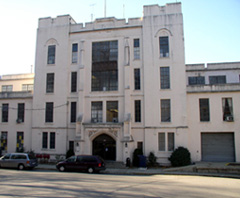Before I get to the title of the post, I'll start with some interesting things I learned.
- All the food on the plane is purchased by undercover Air Force staff members in civilian clothing. Nothing is delivered, so all the food that goes on the plane has been under the direct control of the Air Force since it left the shelves in the grocery stores. To prevent tampering, everything is brought from the US; no food or water will be purchased while out of the country.
- The plane has two real kitchens, not just reheating stations. It has all the implements and tools of a standard kitchen, many of which (knives, scissors, etc) are not allowed on a commercial flight.
- The plane is not actually called Air Force One until the president is on board. If he were flying on a plane operated by the U.S. Navy, the call sign would be Navy One. Just doesn't haven't the same ring.
- The arrival of the plane is meticulously planned. Air Force agents arrive at the destination a few days ahead of the plane and make arrangements. They arrange everything from fuel to where the plane will park. They mark the tarmac with tape to position the plane within a matter of inches.
- The planes are immaculately maintained and thoroughly inspected before every flight. The exterior (some 17,000 square feet) is waxed entirely by hand.
- The president travels with many of his top staff, so he can call a meeting about nearly any topic at any time in the air. The conference room on the plane can conduct a secure video conference with any government agency, and the room can be sealed and soundproofed. There are also secure phone lines, fax machines and copiers, and broadband internet connections.
- Passengers sometimes make personal phone calls while on board. How cool would it be to get a call from Air Force One?
- Air Force One has a twin; two jets are maintained by the Presidential Airlift Group, and both planes travel on every international trip. They are identical in every way, right down to the gold-rimmed plates in the galley.
- Before takeoff, a ground crew sweeps the runway at Andrews AFB (Air Force One's home base) for debris, pebbles, and anything that might cause damage to the engines. I guarantee this doesn't happen at a commercial airport.
- Destination airports must have equipment as mandated by the Secret Service. Anything that doesn't meet these standards, like emergency vehicles and flood lights, is airlifted from Europe and the US.
- Other methods of transportation, including the armored presidential limousines (yes, plural) and Marine helicopters (plural again) are brought along. Air Force cargo transports fly these over before or together with Air Force One.
- The president may choose to cancel his trip at the last minute, causing weeks of planning and millions of dollars of preparation to be spent for nothing.
- Only fuel from trusted sources can be used. Advance agents make arrangements for the purchase, delivery, and testing of fuel at the fuel stops, and the containers are sealed. If the seal is broken, the entire tank is compromised and cannot be used on Air Force One.
- If an airport does not have the facilities to safely store fuel, it will be brought from home. For this Africa trip, seven fuel tanker trucks were flown out on cargo planes to refuel the two 747s before the flight home.














